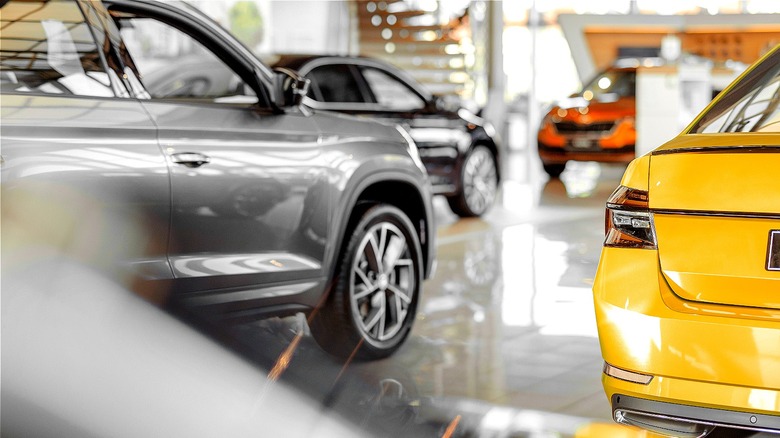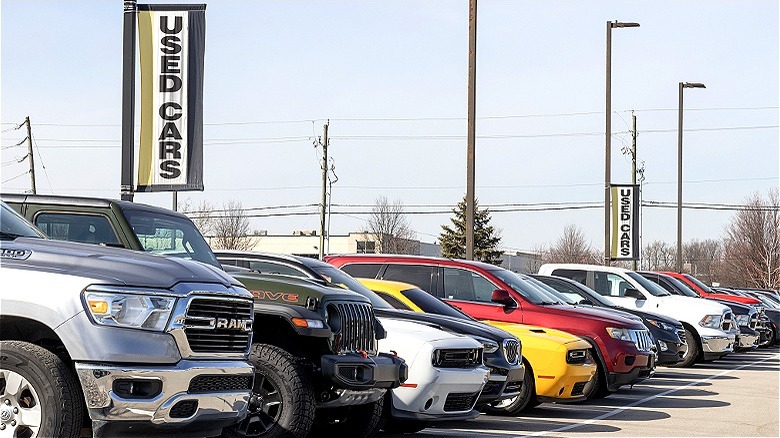Breaking Down The 20/3/8 Car-Buying Rule
Whether you've been looking at new or used cars, chances are you've been waiting for interest rates to come down before committing to the purchase. Unfortunately, the Federal Reserve (or rather this Fed committee that drives interest rates) has not budged on its current rates. In fact, the currently set target range (5.25% to 5.50%) has been in place since July 2023, with the Fed's latest vote on June 12, 2024, maintaining this rate range. As the Fed maintains a wait-and-see approach, you might be wondering how long is too long to wait for a new car.
Budgeting for a brand new car can be complicated enough without the added expense of high interest rates on potential automotive loans. This leads many people to rely on budgeting tools, tips, and rules to help them plan ahead for their large purchases. A particularly popular option has been the 20/3/8 rule, which was first introduced by The Money Guy Show podcast. In this rule, a potential car buyer should plan on following three parameters: put 20% down on their new vehicle, plan on paying off the loan in three years, and ensure they don't spend more than 8% of their pretax income on their car payments. Sounds simple enough, right? While in a perfect, and more financially manageable, world this rule would be relatively easy to follow, the reality of implementing the 20/3/8 car-buying rule in the inflationary environment of 2024 is unrealistic for most people.
Understanding 20/3/8
For starters, it can be important to realize that the 20/3/8 rule is actually a variation of another existing budget guideline: the 20/4/10 rule. This rule is similarly used to calculate purchasing power so you can decide if the car you want fits your existing financial situation. However, there are some key differences between the two. The 20/4/10 guideline still maintains that you should make a 20% down payment, but it instead suggests paying off your loan within four years and ensuring your total transportation costs (not just your loan payment but also insurance, gas, and maintenance expenses) are less than 10% of your monthly income. While this rule gives a buyer an additional year to pay off a car loan, it also minimizes how much of your monthly income you should devote to a vehicle by factoring in total car expenses rather than just a car payment. In this way, you can see why the experts at The Money Guy Show podcast, Brian Preston and Bo Hanson, decided to make their specific variation.
Yet, like many budgeting tricks (looking at you 50/30/20 budget), they fail to factor in some of the major financial hurdles affecting Americans today. Perhaps the most significant discrepancy making these rules unrealistic is the gap between wage growth and inflation in the U.S. If we compare the median household income in 2010 ($50,046) to 2022 ($74,755), we see there was a 49% increase in income over that period. However, the average price of a new car jumped from $24,296 in 2010 to $49,507 in 2022, an almost 104% increase in price.
Unrealistic financials
As of this writing, the average price of a new car in 2024 is $47,433, while the average price of a used car is $25,571. With a 20% down payment, buyers would need to put down almost $9,500 for a new car and just over $5,000 for a used car. However, according to a 2024 Forbes Advisor survey, 28% of Americans reported having less than $1,000 in their personal savings. This makes the first part of the 20/3/8 rule technically possible but unlikely for many. Next, ensuring you can pay off your loan in three years means you're sure to have larger monthly car payments. If we subtract the 20% down payment from a new car, you're left financing about $38,000 to pay off in 36 months.
With the Federal Reserve maintaining interest rates, financing can be a daunting financial prospect. Per Experian's State of the Automotive Finance Market report, Q1 2024, the average auto loan rate on a new car for buyers with super prime (781+) credit scores was 5.38%; however, those with lower scores faced significantly higher rates (i.e., prime was 6.89%, near prime was 9.62%, subprime was 12.85%, and deep subprime was 15.62%). Further, these loan rates increase for used car financing.
Consider, at the prime rate, your monthly payment would be $1,169.75 for a new car. In order for that to be 8% of your pretax income, you'd need to earn roughly $14,600 a month. According to the U.S. Bureau of Labor Statistics, the average salary in the U.S. in 2023 was $65,470.


